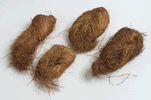
The "spliced and twisted" method of linen yarn production was used in dynastic Egypt. Study of surviving textiles indicates that this technique was used in Egypt between c.3500 and c.600 BC)
As explained on the linen page, flax/linen fibre was removed from the stem of the flax plant by stripping. Fibre obtained in this way was in the form of flat strips, the length equivalent to the height of the main stem of the plant. These were kept until needed in large groups, twisted into hanks, as in the examples below. Here, the strips are about 1 mm wide and their length appears to be about 80 cm. .
 |
UC 7509 Lahun, four twisted hanks of flax fibre, 13-15 cm long, probably late Middle Kingdom, about 1850-1750 BC |
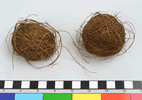 |
UC 7510, from Lahun, two balls of spliced rove, probably late Middle Kingdom, about 1850-1750 BC |
On the Lahun roves, as in textiles of this period, the length of the splice is about 5 cm and the distance between splices c.35 cm. In these extant roves, between the splices, there are always two lengths of strip visible side by side. The method of splicing them together seems to have been that shown in the diagram below. That is, it appears as if two new strips were spliced end to end with the previous two strips, the joins being separately twisted in the Z direction and the two joined elements then plied together in the S direction. Depictions of textile workshops make clear that the splicing was achieved by rubbing the strips against a "platform", probably a large rounded stone. For the splices themselves, the two elements were pushed away from the body by the worker: for the plying, the two were pulled together in the opposite direction, that is, towards the body.
 |
Diagram showing the principle of splicing in Egyptian linen yarn as explained above |
The tradition of making yarn by splicing and twisting has long since ceased to be used in the Middle East. Here, as in Europe, because of the influence of wool usage, "draft spinning", where fibres are gradually drawn from a large loose mass, gradually became the norm also for linen. In the Far East, however, where wool has never been used widely, the several varieties of "spliced and twisted" yarns are made from bast fibres analagous to linen (particularly hemp and ramie). Far Eastern practice would suggest that the two strips seen in the Lahun roves are not wholly separate but rather one long strip folded on itself. The folded end would have been joined to the two loose ends of the previous strip by means of a small longitudinal split.
In prehistoric Egypt (before c.2500 BC), a somewhat different method of yarn production had been used, whereby the splicing and twisting was carried out simultaneously, and the plied construction was continuous throughout the yarn. This early type of linen yarn, which can be termed "twinned", was produced entirely without a spindle, by rubbing the two elements together in the hand or against the thigh or against another surface, such as the mound used later for splicing. The prehistoric textile from the Fayum in the Petrie Museum, UC 72770, has yarns of this type.
Twist is essential because it gives additional strength to the fibres. However, in dynastic Egypt, the twist was added separately at a later stage. In the spliced and twisted method twist was applied to the previously made rove using a spindle.
| Two wooden spindles UC 7306ii, 7809, and a wooden netting needle UC 7806: UC 7306ii (top) is from Lahun, probably late Middle Kingdom, 1850-1750 BC, with modern yarn attached, the other two items are from Gurob, New Kingdom, 1550-1069 BC | |
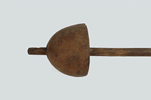 |
Detail of wooden spindle UC 7809 showing whorl and spiral groove for the thread |
The netting needle was used to make knotted nets, in particular, fishing nets such as those illustrated on the page for other uses.
The two spindles illustrated are of different periods and styles, but they are alike in both having a whorl at the top and, above this, a spiral groove. The whorl helps to keep the spindle in motion. The purpose of the spiral seems to have been to allow the end of the part of the rove/yarn that had already been twisted to be more easily hitched to the end of the spindle.
The spindle was set in motion by rubbing the stick down the right thigh and then leaving the spindle to twist freely in the air. Because of the work put into the preparation of the rove, this process was comparatively simple (much simpler than applying the same technique to loose fibres, as in draft spinning). It appears that Egyptian spinners (usually girls or young women) were able to manage two spindles at the same time, and depictions often show this (see below). Depictions also show that the ball of rove was kept in a jar to stop it rolling away. Because dampness is helpful to the spinning of fine linen yarn, the rove was sometimes additionally pulled through a dish of water, the dish being of a special type with a loop at the bottom; the rove was threaded through this.
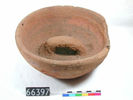 |
Unprovenanced pottery "spinning bowl" UC 66397, Middle Kingdom, about 2025-1750 BC |
Textile workshops
Model from the tomb of Meketra
Ancient Egyptian depictions of textile workshops, whether in the form of tomb models or wall paintings, fit in well with what we can deduce about textile production from the finds of equipment and actual textiles. For example, in the best preserved of the models, that from the tomb of Meketra (early Twelfth Dynasty, about 1950 BC, now in the Metropolitan Museum of Art, New York) we see three young women or girls crouching behind platforms, presumably preparing roves by splicing, and in front of them three more women are spinning, each with two spindles. Also included in this scene are two ground looms, that furthest away in the photograph with two women weavers, and that nearest to us with two weavers and an additional female figure crouched at the far end of the loom. Finally, two women unload two spindles by transferring the yarn onto a group of three pegs set into the wall.
Badari dish
Comparing this scene with a dish in the Petrie Museum from Badari tomb 3802 (UC 9547), we see a very similar workshop, but on a smaller scale. In the foreground is a loom; here only one weaver is shown, but she sits in exactly the same position as one of the weavers in the model, that is, at the side of the loom, close to the "heddle rod". Behind the loom we seem to see a wall with an arrangement where a number of U-shaped pieces of yarn are suspended from a rope or stick. Two women are at work on this.
The Badari dish is comparatively very early, about 3600 BC. However, the similarity of the loom to those in the Middle Kingdom models (as shown below, another view of the Meketra model) suggests that the basic principles of Egyptian weaving, as it continued at least until the Middle Kingdom, were already established by this time.
In the Meketra model, the yarn being wound off the spindles onto the pegs in the wall has been considered by modern writers to be the "warp" or the textile's longitudinal threads, being prepared for the loom. This may be one of the purposes of this activity, but it is noteworthy that on the Badari dish we see only short U-shaped pieces of thread on the wall. These U-shaped pieces are much more suggestive of weft threads, the threads that are inserted into the warp during weaving. Study of surviving textiles has shown that at that very early period and in dynastic Egypt up until the New Kingdom the weft was not made from continuous threads but of short pieces in length being equivalent to just over twice the width of the cloth being woven. These short pieces were inserted from the right of the loom into two consecutive loom "sheds" and indeed when woven are hairpin-shaped. Thus the pegs on the wall of the Meketra may also be for the preparation of the weft, or for both warp and weft.
The sense of a room in a building is forcefully communicated by the Meketra model. Not shown in the photographs is part of a roof which covers the two ends of the model. Probably this workshop was in the lowest floor of the house, perhaps slightly below ground. This situation would have helped maintain a relatively high humidity, something that would have helpful when producing fine linen cloth, as flax/linen fibres are stronger when damp or wet.
A later depiction of a textile workshop, from a painting in the tomb-chapel of Thotnefer at Thebes (18th Dynasty, about 1425), makes clear that this workplace is indeed at a lower level than the main rooms of the house. Here the yarn production activities are much as before, and still carried out by females, but change has taken place in relation to weaving: the looms are now vertical and the weavers apparently male.
LOOMS and weaving.
From studying the depictions and extant textiles we know that the looms used by the Egyptians had a "tubular warp", that is to say, the warp (the longitudinal threads of the textile, set out on the loom before weaving commences) passed around the loom's two beams and met together, joined by a cord or a stick. As weaving progressed, the warp could be simply pulled round the beams so that the "fell" of the fabric was kept in a place convenient to the weavers. The figure at the end of the second loom in the Meketra model is probably pulling the warp around in this way. On the New Kingdom vertical looms, the existence of a subsidiary upper beam around which the warp actually passes, suggests that these warps also were tubular - this subsidiary beam could easily be adjusted in relation to the upper main beam, something that was necessary as weaving progressed and the warp "taken up". On the earlier ground loom, this procedure was achieved simply by loosening the cords holding the beams back against the four pegs.
 |
Lahun heddle jacks |
On these looms, the two sheds (openings in the warp threads) necessary for producing the simple tabby weave were made firstly by a simple "shed stick" and secondly by a heddle rod, consisting of a rod with a series of string loops attached, these loops passing round every second thread in the warp. On the earlier ground loop, the "counter-shed" was created when the heddle stick was raised up onto wooden heddle jacks. A number of such jacks were preserved at Lahun, dating to the late Middle Kingdom, about 1850-1750 BC.
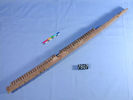 |
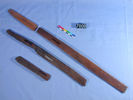 |
An important find from Gurob is a weaving sword, complete except for its handle, dating to the New Kingdom, about 1550-1069 BC. This was used, turned sideways, to open up the shed further, and to beat in the inserted weft. The weft itself was probably inserted with a notched stick.
Also found at Gurob is a loom element, probably part of the beam, most likely that furthest from the weaver. The spaced cuts (c.9mm) do not represent the warp itself but perhaps some means of keeping it in well spaced groups. Minute grooves on the other side of this piece of wood show that it was used to weave textiles where the warp threads were at a density of about 15 per cm.
Very characteristic of larger Egyptian textiles is the selvedge fringe that was created down the left side of the fabric as it was woven. Originally this fringe simply consisted of the ends of the weft hairpins which were taken by the second weaver and as a pair wrapped around the outer warp elements. By the Old Kingdom it was usual to add further looped threads to this fringe to make it more decorative. By the New Kingdom, the practice of weaving with discontinuous weft elements had ceased, but the selvedge fringe, now made only of the additional threads, continued right down to the Roman period for certain textiles.
Most Egyptian textiles have at the first transverse edge, where weaving began, something called a starting border. On Egyptian textiles, this normally consisted of a few thicker threads, or groups of threads, forming a kind of transverse selvedge. The warp loops through the starting border, and the starting border forms a firm and secure edge which requires no further finishing.
After weaving, at the second transverse edge, a fringe of cut warp threads would have remained. In the Old and Middle Kingdoms it was normal to hem this edge and hide the fringe. In the New Kingdom, however, increasingly elaborate knotted fringes became the norm.
The cloths woven for the bag tunics, Egyptian mss, unlike other textiles, have a fringe at both ends.
Sewing and needles. Although sewing was not practised to a high level in ancient Egypt (most clothing needed little or no sewing), good quality needles of various materials have been found at different sites. Most sewing thread was additionally plied.
 |
Naqada copper needle UC 36154 |
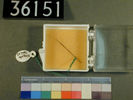 |
silver needle UC 36151 |
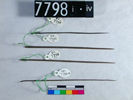 |
Gurob needles UC 7798i-iv |
Laundering.
Linen clothing and other textiles were laundered after weaving and after use. Depictions of laundrymen at work show that the items being washed were treated to violent beating and mangling by twisting. This is a rare example of a laundry bat, a flat wooden implement used to beat the linen during washing.
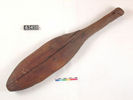 bat for beating flax or for laundry UC 63458
bat for beating flax or for laundry UC 63458
Some artefacts have been identified by modern writers as textile-related, but often without knowledge of textile production in other areas and periods. In particular, the small bone pointed tools from New Kingdom settlement sites such as Gurob and Amarna have been categorised as netting needles or weaving beaters, but modern 'ethnographic' parallels indicate that they might have been used for applying cosmetics or medicinal salves.
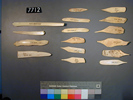 UC 7712 pointed bone tools from Gurob
UC 7712 pointed bone tools from Gurob
The so-called 'reels' in a variety of materials date to the New Kingdom and the Third Intermediate Period, when mummified remains and two-dimensional depictions indicate that large ear studs were worn by both men and women. This function agrees with the materials, form, decoration and parallels from modern African societies.
Copyright © 2003 University College London. All rights reserved.